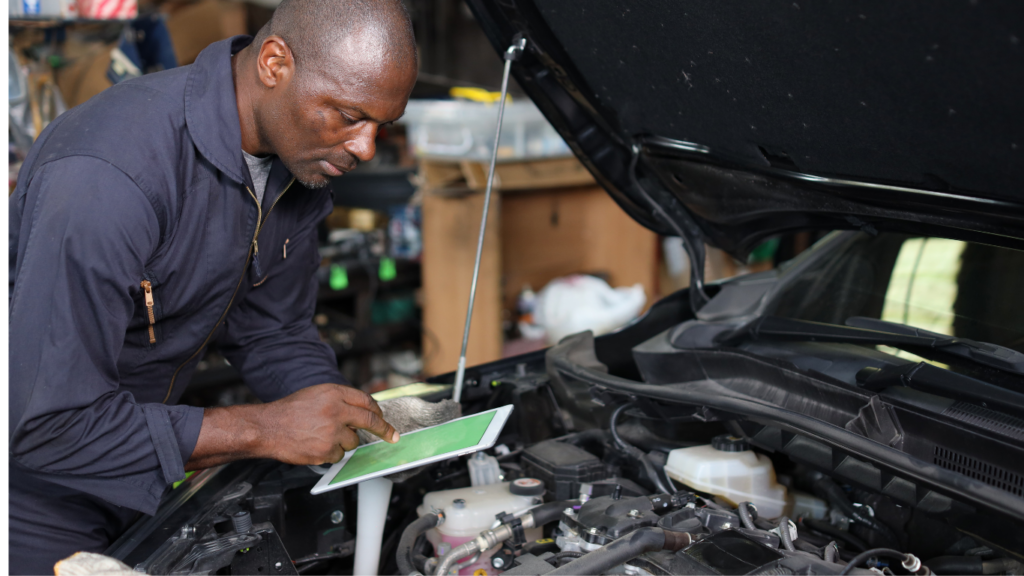Understanding OBD2 Scanners
What Is an OBD2 Scanner?
An OBD2 scanner reads diagnostic information from a vehicle’s onboard computer. These devices connect to the car’s OBD2 port, typically found under the dashboard.
OBD2 stands for On-Board Diagnostics, Version 2, a standardized system for automotive self-diagnostics introduced in 1996 for all cars sold in the US.
How Do OBD2 Scanners Work?
OBD2 scanners communicate with the car’s Engine Control Unit (ECU). The devices access stored trouble codes, which indicate specific issues with engine components, emission controls, and other vital systems.
When connected, the scanner retrieves these codes and displays them on a screen, often with a brief description of the issue.
For example:
- P0171: System Too Lean (Bank 1)
- P0300: Random/Multiple Cylinder Misfire Detected
- P0420: Catalyst System Efficiency Below Threshold
Advanced models provide real-time data, allowing users to monitor engine RPM, coolant temperature, and other parameters. This detailed information helps diagnose problems quickly and efficiently.
Choosing the Right OBD2 Scanner for DIY Car Diagnostics
Selecting the ideal OBD2 scanner involves evaluating specific features and ensuring compatibility with various car models.
Features to Consider
Identifying key features helps choose an effective OBD2 scanner:
- Display: Look for models with clear, easy-to-read screens. An intuitive display simplifies understanding diagnostic codes and live data.
- Data Storage and Playback: Scanners with built-in memory can save data. This feature’s useful for reviewing past diagnostics and tracking recurring issues.
- Live Data: Opt for scanners offering real-time data monitoring. Viewing live parameters like RPM, coolant temperature, and O2 sensor readings aids in precise diagnostics.
- Update Capability: Choose scanners that support software updates. Regular updates ensure access to the latest diagnostic codes and software enhancements.
- User Interface: An easy-to-use interface is crucial. Scanners with straightforward navigation and an easy-to-understand manual make the diagnostic process user-friendly.
- Vehicle Coverage: Confirm the scanner supports a wide range of car brands and models. Many scanners list compatible vehicles, ensuring they work across various makes and years.
- Protocol Support: Verify the scanner supports multiple OBD2 protocols. Vehicles use different communication protocols, like ISO 9141, SAE J1850, and CAN, to interact with diagnostic tools.
- Regional Variations: Consider regional compatibility. Some scanners work specifically with North American, European, or Asian cars, so check if the scanner matches your region’s automotive standards.
- Aftermarket Modifications: Ensure compatibility with any aftermarket modifications. If your vehicle has significant aftermarket enhancements, select a scanner capable of accurately reading modified systems.
Top Picks for the Best OBD2 Scanners

Selecting the best OBD2 scanner enhances DIY car diagnostics efficiency. Here are the top picks based on different needs and budgets.
Best Overall OBD2 Scanner
The BlueDriver Bluetooth Pro OBDII Scan Tool stands out as the best overall OBD2 scanner.
This scanner offers extensive compatibility with both iOS and Android devices, providing a user-friendly interface through its mobile app.
The BlueDriver’s ability to read and clear codes, offer repair reports, and provide live data makes it a preferred choice for DIY enthusiasts. Additionally, its free lifetime updates ensure that you stay current with the latest diagnostic capabilities.
Best Budget-Friendly OBD2 Scanner
For those seeking affordability without compromising functionality, the Autel AutoLink AL319 OBDII Scanner emerges as the best budget-friendly option.
This scanner is an excellent choice for basic diagnostics, reading, and clearing trouble codes. Offering a color display, the AL319 provides easy-to-understand code definitions directly on the screen.
Despite its low cost, it supports all OBD2 protocols, making it suitable for a wide range of vehicles.
Best OBD2 Scanner for Advanced Diagnostics
The Innova 3160g OBDII Diagnostic Scan Tool provides advanced diagnostic features, making it ideal for users needing more in-depth analysis.
This scanner can access ABS, SRS, and enhanced data for specific vehicles. It offers live data streaming, battery and alternator tests, and the ability to reset oil lights.
The 3160g also supports Bluetooth connectivity, enabling real-time data sharing with mobile devices. This advanced functionality makes it perfect for those who require more than basic diagnostic data.
Incorporate these OBD2 scanners into your toolkit to ensure accurate and efficient DIY car diagnostics.
User Experience and Review Insights
Assessing user experience and reviews provides essential insights into the practical utility of OBD2 scanners. These insights help identify ease of use, software reliability, and overall performance.
Ease of Use
User feedback highlights the importance of intuitive, user-friendly interfaces. The BlueDriver Bluetooth Pro OBDII Scan Tool often receives praise for its simplicity and ability to connect seamlessly to smartphones.
Users appreciate its hassle-free setup and straightforward operation, making it accessible even for beginners.
In contrast, the Autel AutoLink AL319 OBDII Scanner’s straightforward button layout and color display make it a budget-friendly option that’s still easy to navigate.
User reviews often commend its ability to quickly read and clear codes without extensive technical knowledge.
For those needing advanced features, the Innova 3160g OBDII Diagnostic Scan Tool provides a balance between complexity and usability.
While its plethora of functions might seem overwhelming, users with some technical background find its detailed instructions and well-organized interface beneficial for both standard and expanded diagnostics.
Software and Updates
Regular software updates ensure OBD2 scanners remain relevant and compatible with newer car models. The BlueDriver Bluetooth Pro stands out here, offering free lifetime updates that users frequently mention as a significant advantage.
They find that software updates enhance functionality and keep up with automotive technology advancements.
For the Autel AutoLink AL319, users value the stability and hassle-free nature of its software, although updates are typically less frequent compared to premium models. The software’s simplicity suffices for basic diagnostic needs.
The Innova 3160g’s software shines in its comprehensive data analysis capabilities. Reviews highlight its frequent updates, which provide users with the latest diagnostics and expanded vehicle coverage.
Coupled with Bluetooth connectivity, software updates and data sharing become efficient and straightforward.
The insights from user experiences and reviews thus underscore the diverse requirements and performance aspects of these top OBD2 scanners, aligning with the varied needs of DIY car enthusiasts.

